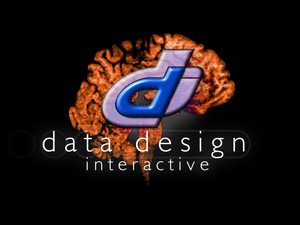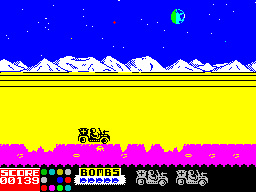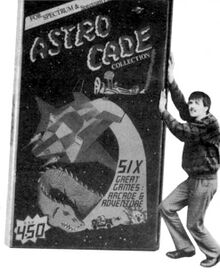Data Design Interactive

Data Design Interactive was a British video game company. Founded in 1983 by Stewart Green as Data Design Systems, the company started off creating budget software for the ZX Spectrum.
History
Formation
I decided I wanted to break into the budget software market — I think the software industry could be killing itself with the £10 game. Budget software like Cascade's 50 Games compilation, has got to be value for money — if you only play each game on a 50 game compilation for ten minutes, then you’ve had over a day’s solid entertainment.
Stewart Green, CRASH[1]
Data Design Systems was founded in 1983 by Stewart Green.[1][2][3] The previous year had seen the release of the ZX Spectrum, an 8-bit home computer that would go on to sell over five million units. While the Spectrum had inferior hardware compared to its competitors like the Commodore 64 and the BBC Micro, the low cost of both the computer and its cassette-based games led to it becoming a successful gaming platform in the United Kingdom.[4] Green had purchased a ZX Spectrum soon after its release, and had spent his free time learning how to program on it before leaving his engineering apprenticeship to pursue a career in software development. He attempted to sell two of his earliest games, Alien and Bomber, for £2 each at computer shows. After selling only a small number of copies, he decided that a compilation of multiple games on one cassette tape would sell better than individual games, as well as allow him to charge a higher price for the tape and let shops take in a larger profit margin.[1]

Green applied for the UK government’s Enterprise Allowance Scheme, an initiative which gave an income of £40 per week for one year to anyone unemployed who wanted to set up their own business and had £1000 of their own funds to invest in the project.[1][5] Deciding to develop for the budget software market, he began work on Astrocade, a collection of six games on one tape. At the same time, he was finding out how to package games properly and learning business practices from his three free interviews with the Business Advice Centre that the Enterprise Allowance Scheme allowed him. Green wanted the compilation to be sold in a large package; he initially planned to use the same cardboard boxes that Beyond Software games used, before he found out that the cardboard dies for that would cost at least £800 and decided to use video boxes instead. Not wanting to pay "hundreds of pounds for a simple piece of artwork," Green got an art student from a local school to create box art for free as portfolio work. Getting game screenshots took two weeks due to the photographer hired not knowing how to take photographs of a television screen.[1]

Development of The Astrocade Collection concluded in late 1985.[2][6] It contained three previously-developed games, Alien, Bomber, and Luna-Rover, as well as three original games, Caverns d'Or, Simeon, and Zombie Island.[7][8] The collection's development ended up costing £3000. Green priced Astrocade at £4.50, but had difficulty distributing it; most distributors did not respond to him, and Smith's wanted the the product to have a barcode, which would cost him another £100. He initially sold copies of Astrocade by offering them on sale at local computer shops.[1] Lacking a budget for advertising, he sent copies of the collection packaged with a Mars bar to computer magazines to encourage reviews.[9] An earlier version of Alien was also published as type-in machine code in the February 1986 issue of Your Sinclair.[10] Graeme Kidd from the ZX Spectrum magazine CRASH interviewed Stewart Green at Data Design, which at the time was operated out of the front room of his house in Halesowen. The interview was published in the May 1986 issue of CRASH; by that point, Green had sold only around one hundred copies of Astrocade.[1] Following this, Green advertised the collection through various computer magazines, giving an address for viewers to mail order the game from.[8]
The Astrocade Collection recieved mixed reviews from contemporary magazines. Reviewers criticised the quality and originality of the games in the collection, though were more positive about the collection's low price and the overall value per game, as well as the collection being Data Design's first major publication.[7][8][11][12] Stewart Green responded with appreciation for the reviews, though he disagreed with the originality of the games being an issue ("How many Exploding Fists are there now?") and criticised Popular Computing Weekly's claim that Luna-Rover had graphics resembling those of a ZX81 game.[13] From July 1986 onward, Data Design lowered the cost of Astrocade to £1.99 (plus 40p for postage and packaging).[14][15]

Green intended for Astrocade to supply him with funds while he developed a larger project. He announced the development of a play-by-mail game in his interview with CRASH; Green believed that the previous summer had been the last chance for self-employed developers to start in the software market, and claimed that small software developers offered the best service for play-by-mail games.[1] Other Spectrum software Green developed and released during 1985–1986[2] included Space Fright, a reskin of Alien,[16] Invadas, a Space Invaders clone,[17] and Elite Editor, an editor for the ZX Spectrum version of David Braben and Ian Bell's Elite.[18][19] Data Design Systems also published programs for ZX Spectrum software development, including BASIC +, a collection of six programs for writing software in BASIC, in 1986,[19][20] and Sprite Designer, Printer, and 64 Column Display in 1987.[21] BASIC + was originally released for £5.99, later increased to £12; following the release of the other three programs it was priced at £10 while the others were available for £6 each, or all four could be purchased together for £14.[19][20][21]
PSS
In his interview with CRASH, Stewart Green expressed that he may have to take up freelance work to survive as a small software house.[1] Beginning in 1987, Data Design Systems developed ZX Spectrum ports of Commodore 64 games for Personal Software Services (PSS).
References
- ↑ a b c d e f g h i Kidd, Graeme (May 1986). "This Little Proggy Went To Market...". CRASH - The Online Edition. No. 28. Newsfield Publications Ltd. p. 76. Archived from the original on 25 June 2023.
- ↑ a b c History. datadesign.uk.com. Data Design Interactive. Archived from the original on 16 December 2004.
- ↑ Younghusband, Paul (February 2001). "A One Stop Digital Shop: Data Design Interactive and Artworld UK". Animation World Magazine. Vol. 5, No. 11. AWN, Inc. Archived from the original on 18 January 2023. Mirror available at Animation World Network.
- ↑ Mason, Graeme (18 February 2022). "ZX Spectrum at 40: a look back". NME. Archived from the original on 23 June 2023.
- ↑ Dellheim, Charles (1 July 1996). "Thatcher's Self Employment". Inc. Archived from the original on 15 April 2003. Retrieved 25 June 2023.
- ↑ Green, Stewart (1 November 1985). Alien (Astrocade version). Data Design Systems. Title screen. "© 1.11.85".
- ↑ a b Taylor, Graham (1 May 1986). "New releases". Popular Computing Weekly. Vol. 5 No. 18. Sunshine Publications. pp. 44–45.
- ↑ a b c Phillips, Max (July 1986). "Screen Shots". Your Sinclair. Issue 7. Sportscene Specialist Press. p. 61.
- ↑ Mangram, Lloyd (April 1986). "Merely Mangram". CRASH. No. 27. Argus Specialist Publications. p. 112.
- ↑ Cox, Kevin (ed.) (February 1986). "Alien by Stewart Green". Your Sinclair. Issue 2. Sportscene Specialist Press. pp. 48–52.
- ↑ Kidd, Graeme (June 1986). "The Games Gatherings". CRASH. No. 29. Newsfield Publications Ltd. pp. 98–99.
- ↑ Hetherington, Tony (June 1986). "Adventure Reviews". Computer Gamer. No. 15. Newsfield Publications Ltd. p. 39.
- ↑ Green, Stewart (26 June 1986). "Review reaction". Popular Computing Weekly. Vol. 5 No. 26. Sunshine Publications. p. 10.
- ↑ Astrocade advertisement. Computer Gamer. No. 16, July 1986. Newsfield Publications Ltd. p. 29.
- ↑ South, Phil (September 1986). "Frontlines". Your Sinclair. Issue 9. Sportscene Specialist Press. p. 5.
- ↑ Evans, Gary (ed.) (May 1986). "Software Exchange". Your Computer. Vol. 6 No. 5. Focus Investments Ltd. p. 66.
- ↑ Cox, Kevin (ed.) (July 1986). https://archive.org/details/Your_Sinclair_007/page/48/mode/1up?view=theater "Invadas by Stewart Green"]. Your Sinclair. Issue 7. p. 48.
- ↑ Green, Stewart (August 1986). "Six games for £1.99". CRASH. No. 31. Newsfield Publications Ltd. p. 59.
- ↑ a b c Green, Stewart (September 1986). "Data Design". Your Sinclair. Issue 9. p. 93.
- ↑ a b Green, Stewart (January 1987). "Data Design". Your Sinclair. Issue 13. Sportscene Specialist Press. p. 123.
- ↑ a b Green, Stewart (February 1987). "D.D.S. The Programming Specialists". Your Sinclair. Issue 14. Sportscene Specialist Press. p. 100.
